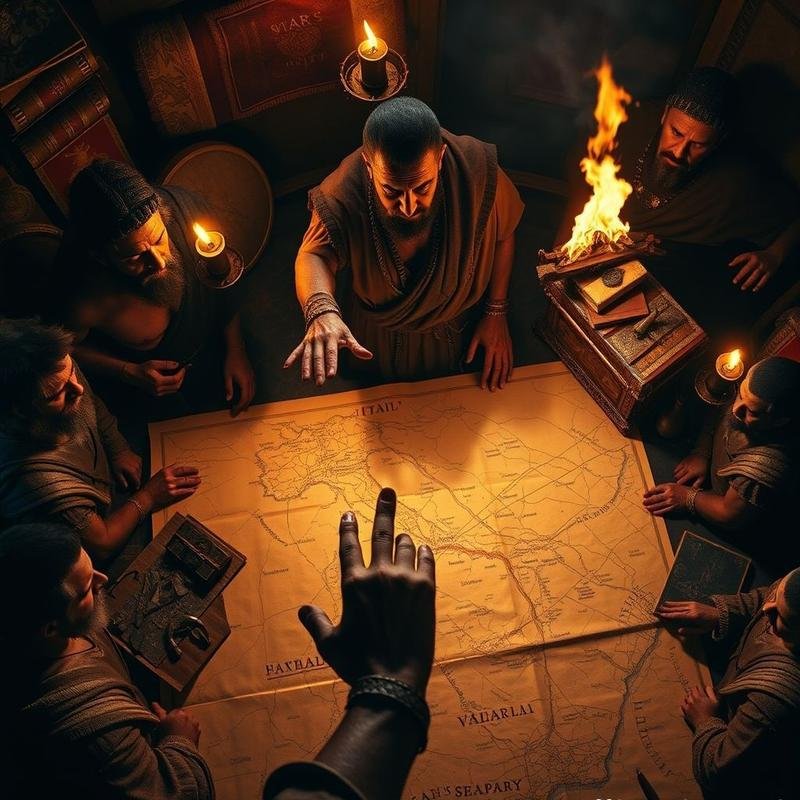Hannibal’s Victory: Reassessing a World Without Roman Hegemony.

Hannibal’s Victory: Reassessing a World Without Roman Hegemony.
Prior to the clash of legions and Hannibal’s audacious crossing of the Alps with his elephants, the Mediterranean world stood at a precarious juncture. Rome, a republic forged through relentless expansion and hardened by centuries of warfare, held dominion over the Italian peninsula. Across the sea, Carthage, founded by Phoenician traders in the 9th century BC, commanded a vast maritime empire encompassing North Africa, Iberia, and the western Mediterranean islands. This was not merely a military conflict, but a clash of civilizations, each possessing unique strengths and ambitions. Rome, with its citizen-soldiers and unwavering focus on land-based expansion, stood in stark contrast to Carthage, a mercantile empire built upon naval supremacy and mercenary armies. The control of Sicily, a strategically vital island, ignited the conflict. The Mamertines, a band of Campanian mercenaries, seized Messana, triggering hostilities with Syracuse. Both Syracuse and the Mamertines appealed for assistance. Rome and Carthage, recognizing an opportunity to expand their influence, responded. The year was 264 BC. The stage was set. War was inevitable.
## Hannibal’s Gamble: A Master Strategist’s Bold Plan
Hannibal Barca, a name forever etched in military history, inherited not only command but also a fervent desire to avenge Carthage’s defeat in the First Punic War. His strategic objective was audacious: to cripple Rome’s Italian heartland, shatter its alliances, and impose a peace on Carthaginian terms. He recognized the futility of a direct naval assault against Rome’s superior fleet. Instead, he conceived a land invasion, a maneuver so improbable it bordered on the impossible. In 218 BC, Hannibal marched his army—including war elephants—from New Carthage across the Pyrenees and the Alps. This was not merely a military campaign; it was a logistical nightmare. The Alpine crossing alone, with its treacherous terrain, hostile tribes, and brutal weather, cost him thousands of men. Yet, Hannibal persevered, his determination fueled by a deep understanding of Roman vulnerabilities. He knew that Rome’s strength lay in its network of alliances, but that these allies, often subjugated, harbored resentment. He aimed to exploit this discontent, offering them liberation from Roman rule. Could he truly sever Rome’s grip on Italy? Hannibal’s military brilliance lay in his adaptability and tactical innovation. At the Battle of Cannae in 216 BC, he orchestrated one of the most devastating defeats in Roman history, encircling and annihilating a vastly larger Roman army. His use of terrain, combined arms tactics, and psychological warfare showcased his mastery of the battlefield. Despite inflicting such heavy losses, Hannibal never aimed to conquer Rome directly. His goal was to incite rebellion among Rome’s allies and force them to the negotiating table.
## Cannae: The Slaughter That Shook Rome
Cannae became a killing field. Hannibal, consistently outnumbered but never outwitted, meticulously prepared the battlefield. He positioned his weakest infantry, a mix of Gauls and Iberians, in a convex line facing the Roman legions. This seemingly suicidal move was the linchpin of his strategy. As the Roman legions, reportedly numbering around 86,000, surged forward, eager to crush the seemingly weak Carthaginian center, Hannibal’s men slowly retreated, creating a crescent-shaped pocket. The Romans, driven by a thirst for blood, pressed deeper and deeper into this deadly trap. Then, Hasdrubal’s Iberian and Numidian cavalry shattered the Roman cavalry. Circling behind the advancing legions, they sealed their doom. From the rear, Hasdrubal unleashed a devastating attack, while Hannibal’s elite Libyan infantry, held in reserve, flanked the now completely entrapped Romans. The result? A massacre. Trapped and surrounded, the Roman legions were systematically cut down. Historians estimate that over 50,000 Roman soldiers perished that day, including a significant number of senators – a catastrophic loss that plunged Rome into deep mourning and threatened the very survival of the Republic.
## Cannae: A Pyrrhic Victory
Cannae was a moment of unparalleled triumph that masked a deeper strategic failure. Hannibal, despite annihilating Roman armies, lacked the logistical capacity and manpower to deliver the killing blow – the capture of Rome itself. His army, though formidable, was an army of invasion, not occupation. The Carthaginian senate, dominated by mercantile interests, consistently failed to provide adequate reinforcements and supplies, prioritizing short-term profits over long-term strategic goals. They were unwilling to fully commit to a war that demanded immense resources and unwavering dedication. Simultaneously, Rome demonstrated remarkable resilience. Following Cannae, instead of collapsing, the Roman Senate, led by figures like Fabius Maximus, adopted a strategy of attrition, avoiding direct confrontation with Hannibal’s main force. They harassed his supply lines, chipped away at his allies, and rebuilt their armies with relentless determination. New legions were raised, often manned by citizen-soldiers, demonstrating an unwavering commitment to the Republic. The Roman social structure, while hierarchical, fostered a sense of collective responsibility and civic duty that Carthage, with its reliance on mercenaries and internal political divisions, could not match. Crucially, Rome’s allies largely remained loyal, denying Hannibal the widespread support he needed to cripple the Republic. The capture of Syracuse in 212 BC by Marcellus marked a turning point, showcasing Rome’s renewed military strength and strategic adaptability. Hannibal’s inability to decisively exploit his victories, coupled with Rome’s extraordinary resilience, ultimately sealed Carthage’s fate.
## What if Hannibal Conquered Rome? A World Transformed
Imagine a world where Hannibal Barca pressed his advantage after Cannae, seizing Rome itself. The implications are staggering. The immediate aftermath would see the dismantling of the Roman Republic. Hannibal, ever the pragmatist, would likely install a Carthaginian-backed oligarchy, composed of disaffected Roman elites and allied Italian cities eager to break free from Roman dominance. This new order, however, would be inherently unstable. The Roman spirit, though wounded, would not be broken. Resistance movements would inevitably spring up, fueled by resentment and the enduring memory of Republican ideals. Economically, the Mediterranean would likely become heavily influenced by Carthage, its waters controlled by Punic ships. Roman trade routes might be diverted to Carthage, potentially enriching its merchant class and solidifying its control over vital resources. Cities that had thrived under Roman rule might suffer, while others allied to Carthage could flourish. The vast wealth accumulated by Rome might be plundered, further weakening its ability to recover. Culturally, the triumph of Carthage might have prevented the widespread dissemination of Roman law, language, and architecture as it occurred historically. The Latin language might have remained a regional dialect. Roman architectural innovations might not have spread as rapidly or widely. The Greco-Roman synthesis, the cornerstone of Western civilization, would potentially be altered, perhaps influenced by Punic-Hellenistic elements. The course of European history would be unrecognizably different, a world where the echoes of Carthage, not Rome, resonate through the ages, a testament to what might have been. The absence of a Roman Empire would drastically affect cultural transmission. The standardization of law, language, and infrastructure that Rome imposed across its vast territories would not have occurred. Local cultures might have flourished, leading to a more fragmented and diverse Europe. Imagine a tapestry of Celtic, Iberian, and Etruscan traditions continuing to evolve without Roman suppression, potentially leading to unique artistic and philosophical movements. Furthermore, the spread of Christianity, so heavily influenced by Roman institutions and infrastructure, would have followed a vastly different trajectory, perhaps remaining a localized sect or taking on entirely different forms. The very concept of Western Civilization, built upon Greco-Roman foundations, would be unrecognizable. Instead, a mosaic of cultures shaped by Punic trade, Celtic traditions, and the enduring influence of the Hellenistic world might have emerged, creating a far more diverse and decentralized continent.
## Carthage’s Enduring Influence?
Had Hannibal decisively triumphed, the Mediterranean landscape would have been irrevocably altered. A victorious Carthage would likely have fostered a decentralized, mercantile network rather than a centralized empire. Punic trading networks could have expanded further, potentially reaching the British Isles and solidifying their dominance over Iberian resources. This economic supremacy might have spurred different technological advancements. The Carthaginian focus on maritime technology and efficient agriculture could have led to innovations in shipbuilding, irrigation, and crop rotation centuries earlier than their actual development. Imagine Carthaginian galleys circumnavigating Africa or establishing trade colonies in the Americas long before European explorers. The echoes of Hannibal’s near victory resonate even now, millennia later. The Punic Wars demonstrate that even the most formidable empire can be brought to the brink by a single, brilliant strategist. Hannibal’s genius lay not only in his battlefield tactics but also in his understanding of Roman vulnerabilities. His failure underscores the critical importance of logistical support and the unwavering resolve of a unified populace, factors Carthage ultimately lacked. The Roman resilience serves as a potent reminder that strategic patience and adaptability can overcome even the most devastating initial setbacks. The Punic Wars were more than just a clash of arms; they were a crucible forging the very identity of Rome. The victory cemented Rome’s dominance, but the near miss instilled a deep-seated fear of external threats, shaping Roman foreign policy for centuries to come. The destruction of Carthage became a symbol of Roman ruthlessness—a scorched-earth policy meant to eliminate any potential rival. But consider this: even in defeat, Carthage left an indelible mark. The fear Hannibal instilled in Rome spurred its military reforms and expansion, ultimately shaping the empire that would dominate Europe for centuries. The Carthaginian model of a maritime empire, focused on trade and resource control, foreshadowed later European colonial powers. The Punic Wars serve as a timeless lesson in the fragility of power and the enduring impact of strategic leadership, both in victory and defeat. They stand as a testament








